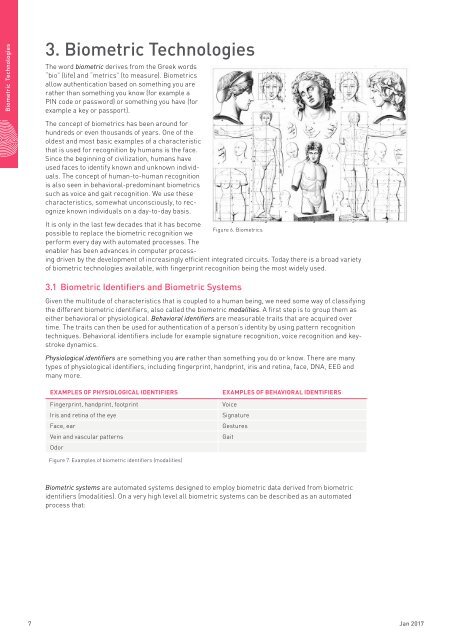BIOMETRIC
Fingerprints-Biometric-Technologies-Whitepaper-January-2017-RevB
Fingerprints-Biometric-Technologies-Whitepaper-January-2017-RevB
Create successful ePaper yourself
Turn your PDF publications into a flip-book with our unique Google optimized e-Paper software.
Biometric Technologies<br />
3. Biometric Technologies<br />
The word biometric derives from the Greek words<br />
“bio” (life) and “metrics” (to measure). Biometrics<br />
allow authentication based on something you are<br />
rather than something you know (for example a<br />
PIN code or password) or something you have (for<br />
example a key or passport).<br />
The concept of biometrics has been around for<br />
hundreds or even thousands of years. One of the<br />
oldest and most basic examples of a characteristic<br />
that is used for recognition by humans is the face.<br />
Since the beginning of civilization, humans have<br />
used faces to identify known and unknown individuals.<br />
The concept of human-to-human recognition<br />
is also seen in behavioral-predominant biometrics<br />
such as voice and gait recognition. We use these<br />
characteristics, somewhat unconsciously, to recognize<br />
known individuals on a day-to-day basis.<br />
It is only in the last few decades that it has become<br />
Figure 6. Biometrics<br />
possible to replace the biometric recognition we<br />
perform every day with automated processes. The<br />
enabler has been advances in computer processing<br />
driven by the development of increasingly efficient integrated circuits. Today there is a broad variety<br />
of biometric technologies available, with fingerprint recognition being the most widely used.<br />
3.1 Biometric Identifiers and Biometric Systems<br />
Given the multitude of characteristics that is coupled to a human being, we need some way of classifying<br />
the different biometric identifiers, also called the biometric modalities. A first step is to group them as<br />
either behavioral or physiological. Behavioral identifiers are measurable traits that are acquired over<br />
time. The traits can then be used for authentication of a person’s identity by using pattern recognition<br />
techniques. Behavioral identifiers include for example signature recognition, voice recognition and keystroke<br />
dynamics.<br />
Physiological identifiers are something you are rather than something you do or know. There are many<br />
types of physiological identifiers, including fingerprint, handprint, iris and retina, face, DNA, EEG and<br />
many more.<br />
EXAMPLES OF PHYSIOLOGICAL IDENTIFIERS<br />
Fingerprint, handprint, footprint<br />
Iris and retina of the eye<br />
Face, ear<br />
Vein and vascular patterns<br />
Odor<br />
EXAMPLES OF BEHAVIORAL IDENTIFIERS<br />
Voice<br />
Signature<br />
Gestures<br />
Gait<br />
Figure 7. Examples of biometric identifiers (modalities)<br />
Biometric systems are automated systems designed to employ biometric data derived from biometric<br />
identifiers (modalities). On a very high level all biometric systems can be described as an automated<br />
process that:<br />
7 Jan 2017


